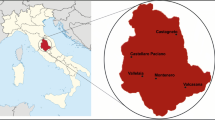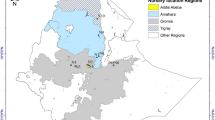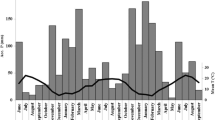Abstract
Owners of black truffle (Tuber melanosporum) plantations are concerned about the persistence of its mycorrhizas and mycelium in the soil, especially until the appearance of the “truffle burn” areas and the triggering of sporocarp production, at least 5–7 years after planting truffle-inoculated seedlings. During this period, the farmer does not know whether his management is promoting black truffle development. To study the presence and abundance of T. melanosporum ectomycorrhizas in plantations, two sampling methods, direct sampling of root tips and soil core collection, are compared by analyzing 48 evergreen oak trees (Quercus ilex) inoculated with truffle. Those trees are grouped by age (<6, 6–9, >9 years old) and presence or absence of truffle production. T. melanosporum was present in 46 out of the 48 studied trees, and its ectomycorrhizas appeared in 65 % of the ectomycorrhizal tips. Its abundance is significantly higher with productive trees and young trees. Direct sampling of root tips and soil core collection were equally effective in detecting this species, although soil core collection proved a better method to also evaluate ectomycorrhizal fungal diversity. To detect the presence of T. melanosporum in a given plantation, three samples suffice, with a single sample per random tree. Although the presence of mycorrhizas is not a sure sign of the future success of a black truffle plantation, its absence influences managers as to whether to continue culturing truffles in a plantation.

Similar content being viewed by others
References
Agerer R (1991) Characterization of ectomycorrhiza. In: Norris JR, Read DJ, Varma A (eds) Techniques for the study of mycorrhiza. Methods Microbiol 23:25–73
Agerer R (2006) Fungal relationships and structural identity of their ectomycorrhizas. Mycol Prog 5:67–107
Agerer R, Rambold G (2004–2013) [first posted on 2004–06–01; most recent update: 2011–01–10]. DEEMY—An information system for characterization and determination of ectomycorrhizae. www.deemy.de München, Germany
Águeda B, Fernández-Toirán LM, De Miguel AM, Martínez-Peña F (2010) Ectomycorrhizal status of a mature productive black truffle plantation. For Syst 19(1):89–97
Alonso-Ponce R, Águeda B, Ágreda T, Modrego MP, Aldea J, Martínez-Peña F (2010) Un modelo de potencialidad climática para la trufa negra (Tuber melanosporum) en Teruel (España). For Syst 19(2):208–220
Bonet JA, Fischer CR, Colinas C (2001) Evolución mensual en campo de las ectomicorrizas de Tuber melanosporum Vitt. inoculadas en plantas de Quercus ilex. Montes para la sociedad del nuevo milenio. Actas del III Congreso Forestal Español. Ed. Junta de Andalucía. Granada. pp 849–853
Bravo A, Montero G (2008) Descripción de los caracteres culturales de las principales especies forestales de España. In: Serrada R, Montero G, Reque JA (eds) Compendio de selvicultura aplicada en España. INIA, Madrid, pp 1039–1114
Chevalier G, Sourzat P (2012) Soils and techniques for cultivating Tuber melanosporum and Tuber aestivum in Europe. In: Zambonelli A, Bonito GM (eds) Edible ectomycorrhizal mushrooms, current knowledge and future prospects. Soil biology 34. Springer London Ltd, London, pp 163–189
De la Varga H, Águeda B, Martínez-Peña F, Parladé J, Pera J (2012) Quantification of extraradical soil mycelium and ectomycorrhizas of Boletus edulis in a Scots pine forest with variable sporocarp productivity. Mycorrhiza 22:59–68
De la Varga H, Águeda B, Ágreda T, Martínez-Peña F, Parladé J, Pera J (2013) Seasonal dynamics of Boletus edulis and Lactarius deliciosus extraradical mycelium in pine forests of central Spain. Mycorrhiza 23:391–402
De Miguel AM, Sáez R (2005) Algunas micorrizas competidoras de plantaciones truferas. Publ Biol Univ Navarra Ser Bot 16:1–18
García-Barreda S, Reyna S, Pérez R, Rodríguez JA, Domínguez JA (2012) Ecología de la trufa y las áreas truferas. In: Reyna S (ed) Truficultura. Fundamentos y técnicas, 2nd edn. Mundi Prensa, Madrid, pp 151–206
Giraud M (1988) Prélèvement et analyse de mycorhizes. Centre Technique Interprofessionnel des Fruits et Légumes CTIFL (ed). La Truffe 10:49–63
González-Armada B, De Miguel AM, Cavero RY (2010) Ectomycorrhizae and vascular plants growing in brûlés as indicators of below and above ground microecology of black truffle production areas in Navarra (Northern Spain). Biodivers Conserv 19:3861–3891
Hall I, Brown G, Zambonelli A (2007) Taming the truffle. The history, lore and science of the ultimate mushroom. Timber Press, Portland, OR
Kennedy P (2010) Ectomycorrhizal fungi and interspecific competition: species interactions, community structure, coexistence mechanisms, and future directions. New Phytol 187:895–910
Le Tacon F, Zeller B, Plain C, Hossann C, Bréchet C, Robin C (2013) Carbon transfer from the host to Tuber melanosporum mycorrhizas and ascocarps followed using a 13C pulse-labeling technique. PLoS ONE 8(5):e64626. doi:10.1371/journal.pone.0064626
Montgomery DC (2001) Design and analysis of experiments. John Wiley & Sons, Inc, New York (USA)
Murat C, Vizzini A, Bonfante P, Mello A (2005) Morphological and molecular typing of the below-ground fungal community in a natural Tuber magnatum truffle-ground. FEMS Microbiol Lett 245:307–313
Napoli C, Mello A, Borra A, Vizzini A, Sourzat P, Bonfante P (2010) Tuber melanosporum, when dominant, affects fungal dynamics in truffle grounds. New Phytol 185(1):237–247
Olivier JM, Savignac JC, Sourzat P (2012) Truffe et trufficulture. Ed. Fanlac, Perigueux, France
Parladé J, De la Varga H, De Miguel AM, Sáez R, Pera J (2013) Quantification of extraradical mycelium of Tuber melanosporum in soils from truffle orchards in northern Spain. Mycorrhiza 23:99–106
Pérez-Collazos E, Barriuso J, Sánchez S, Palazón C (2010) Molecular identification of truffles. Atti del 3º Congresso Internazionale di Spoleto sul Tartufo. Spoleto, Italy, pp 122–129
Ragnelli AM, Aimola P, Maione M, Zarivi O, Leonardi M, Pacioni G (2013) The cell death phenomenon during Tuber ectomycorrhiza morphogenesis. Plant Biosyst. doi:10.1080/11263504.2013.788575
Rauscher T, Agerer R, Chevalier G (1995) Ektomykorrhizen von Tuber melanosporum, Tuber mesentericum und Tuber rufum (Tuberales) an Corylus avellana. Nova Hedwigia 61(3–4):281–322
Reyna S, Colinas C (2012) Truficultura. In: Reyna S (ed) Truficultura. Fundamentos y técnicas, 2nd edn. Mundi Prensa, Madrid, pp 235–274
Reyna S, De Miguel AM (2012) Las micorrizas. Ciclo biológico de la trufa. In: Reyna S (ed) Truficultura. Fundamentos y técnicas, 2nd edn. Mundi Prensa, Madrid, pp 105–150
Sáez García Falcés R, De Miguel Velasco AM (2008) La trufa: guía de truficultura. Instituto Técnico y de Gestión Agrícola S.A., Navarra, Spain
SPSS (2012) IBM SPSS advanced statistics 21. IBM Corporation, Inc, New York (USA)
Streiblová E, Gryndlerová H, Gryndler M (2012) Truffle brûlé: an efficient fungal life strategy. FEMS Microbiol Ecol 80(1):1–8
Suz LM, Martín MP, Oliach D, Fischer CR, Colinas C (2008) Mycelial abundance and other factors related to truffle productivity in Tuber melanosporum-Quercus ilex orchards. FEMS Microbiol Lett 285(1):72–78
Taylor A (2002) Fungal diversity in ectomycorrhizal communities: sampling effort and species detection. Plant Soil 244:19–28
Zambonelli A, Salomoni S, Pisi A (1993) Caratterizzazione anatomo-morfologica delle micorrize di Tuber spp. su Quercus pubescens Willd. Micol Ital 3:73–90
Zampieri E, Murat C, Cagnasso M, Bonfante P, Mello A (2010) Soil analysis reveals the presence of an extended mycelial network in a Tuber magnatum truffle-ground. FEMS Microbiol Ecol 71:43–49
Zampieri E, Rizzello R, Bonfante P, Mello A (2012) The detection of mating type genes of Tuber melanosporum in productive and non productive soils. Appl Soil Ecol 57:9–15
Acknowledgements
This work was supported by the INIA (Ministerio de Ciencia e Innovación, Gobierno de España) projects PET 2007-13-C07-01 and PET 2007-13-C07-05. A part of it was carried out in the currently closed down Centro de Investigación Forestal de Valonsadero (Junta de Castilla y León, Spain).
The accurate suggestions, ideas, and editions of the guest editor of this special issue, Prof.ssa Alessandra Zambonelli, the editor of Mycorrhiza, Dr. Randy Molina, and those two anonymous reviewers have improved the early versions of this manuscript.
The authors would like to acknowledge the support, both in the field and lab, of Manuel Redón Iserte, Silvia Sánchez, and Fernando Castellote as well as the owners of the plantations for their selfless help.
Author information
Authors and Affiliations
Corresponding author
Rights and permissions
About this article
Cite this article
Sánchez, S., Ágreda, T., Águeda, B. et al. Persistence and detection of black truffle ectomycorrhizas in plantations: comparison between two field detection methods. Mycorrhiza 24 (Suppl 1), 39–46 (2014). https://doi.org/10.1007/s00572-014-0560-0
Received:
Accepted:
Published:
Issue Date:
DOI: https://doi.org/10.1007/s00572-014-0560-0




